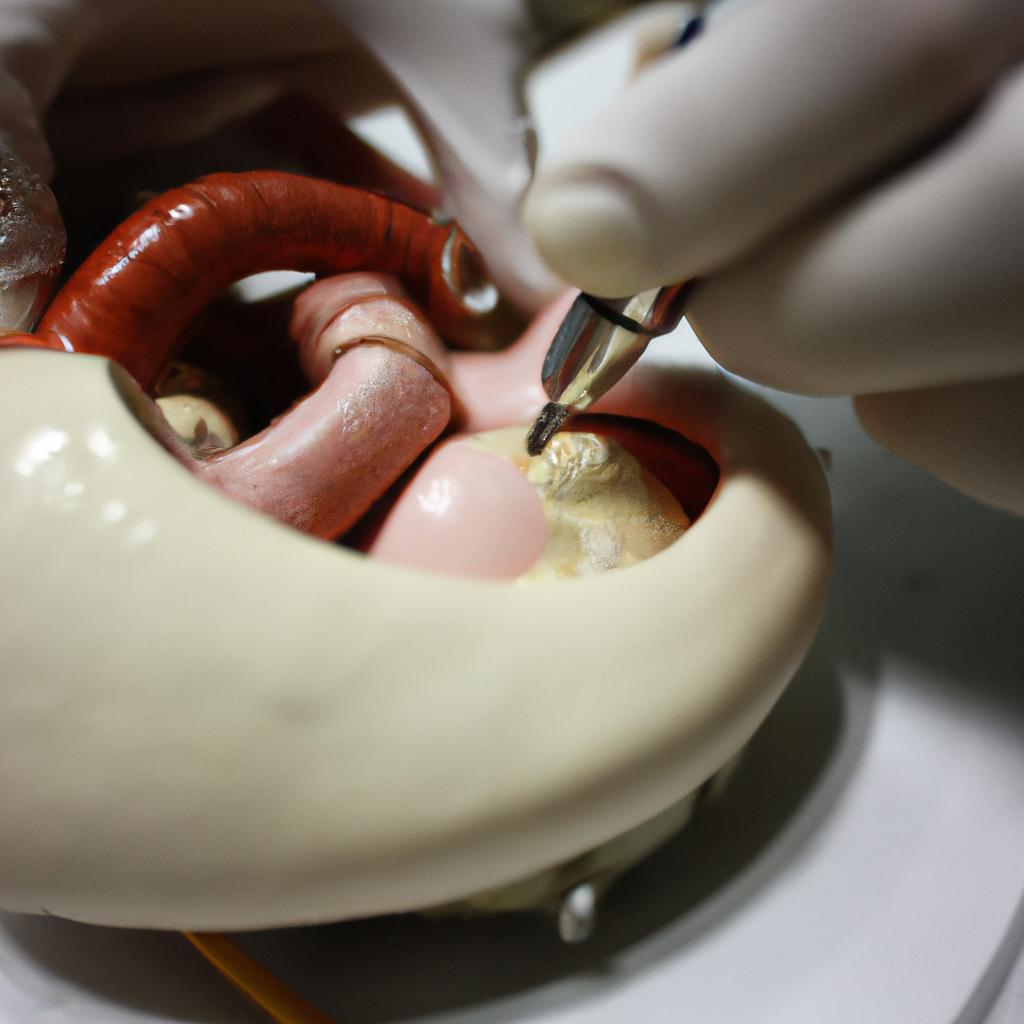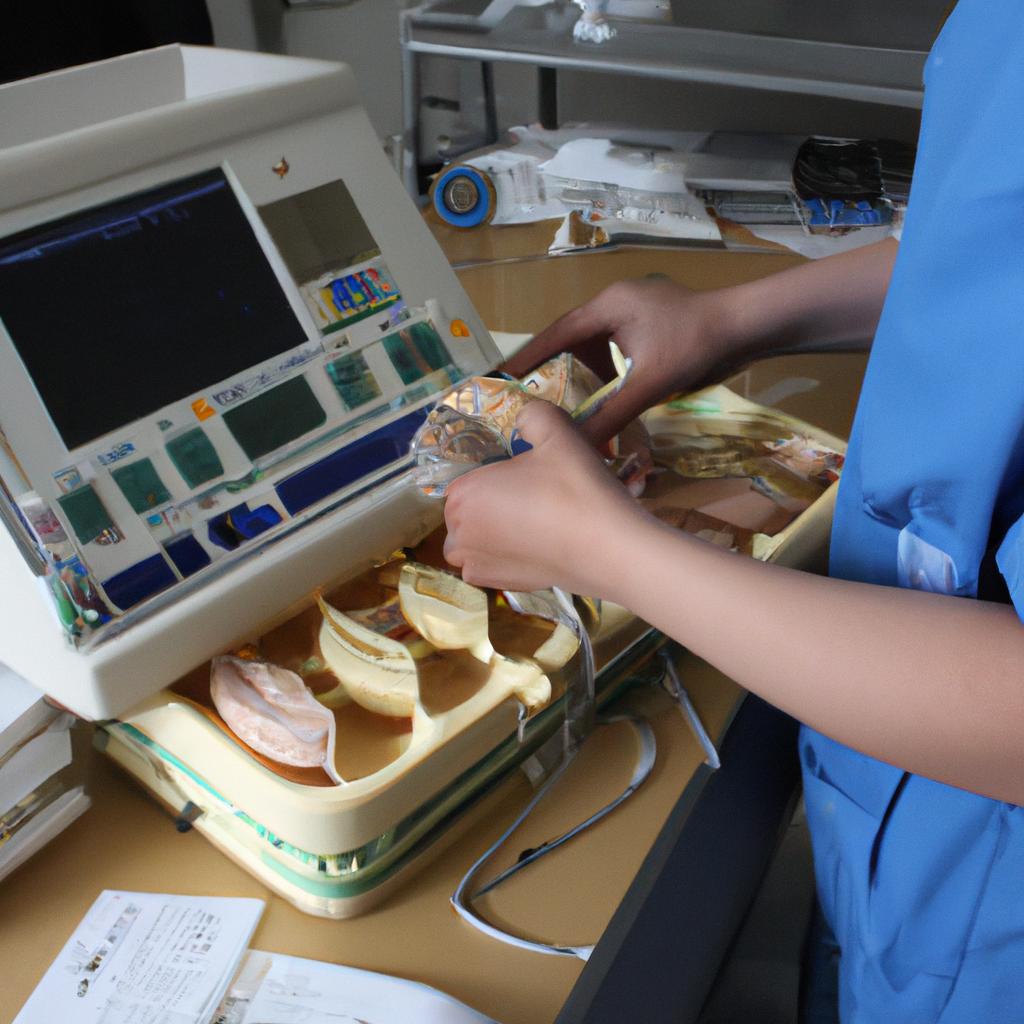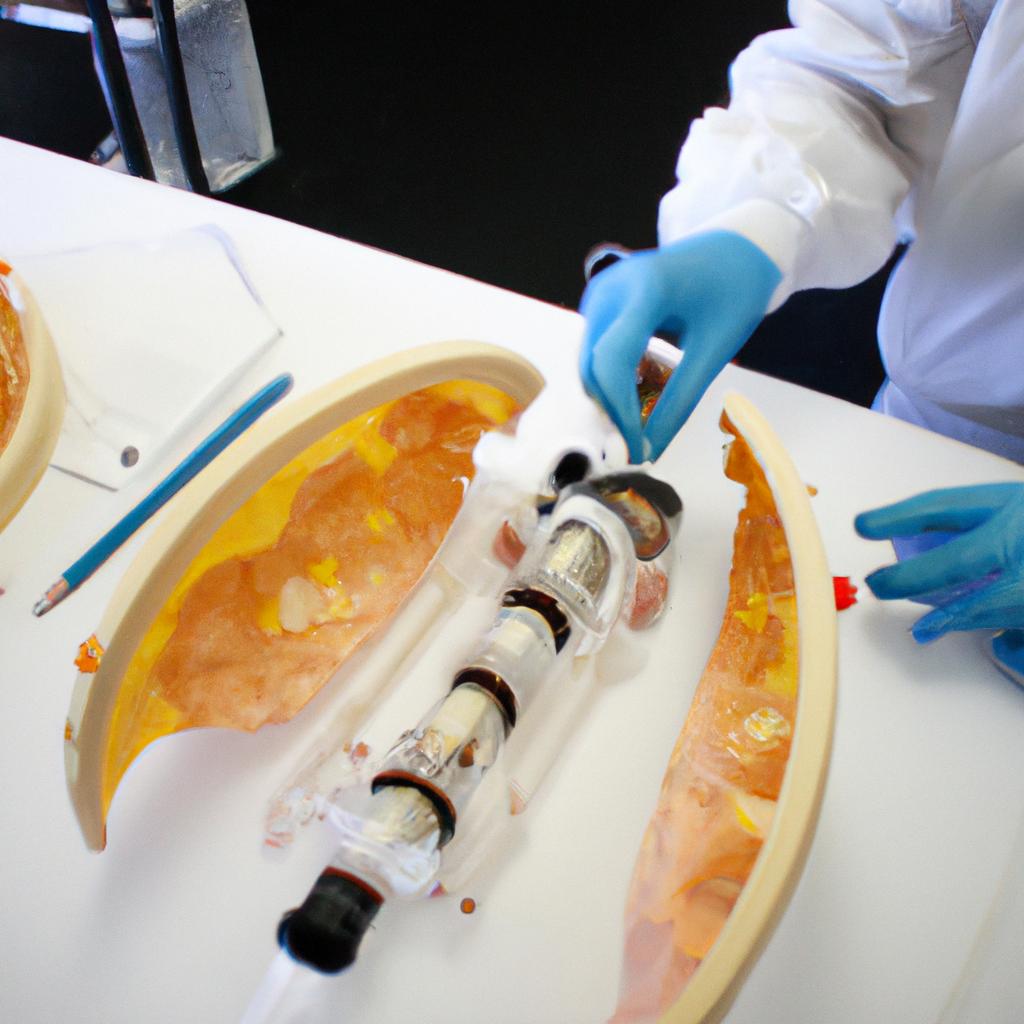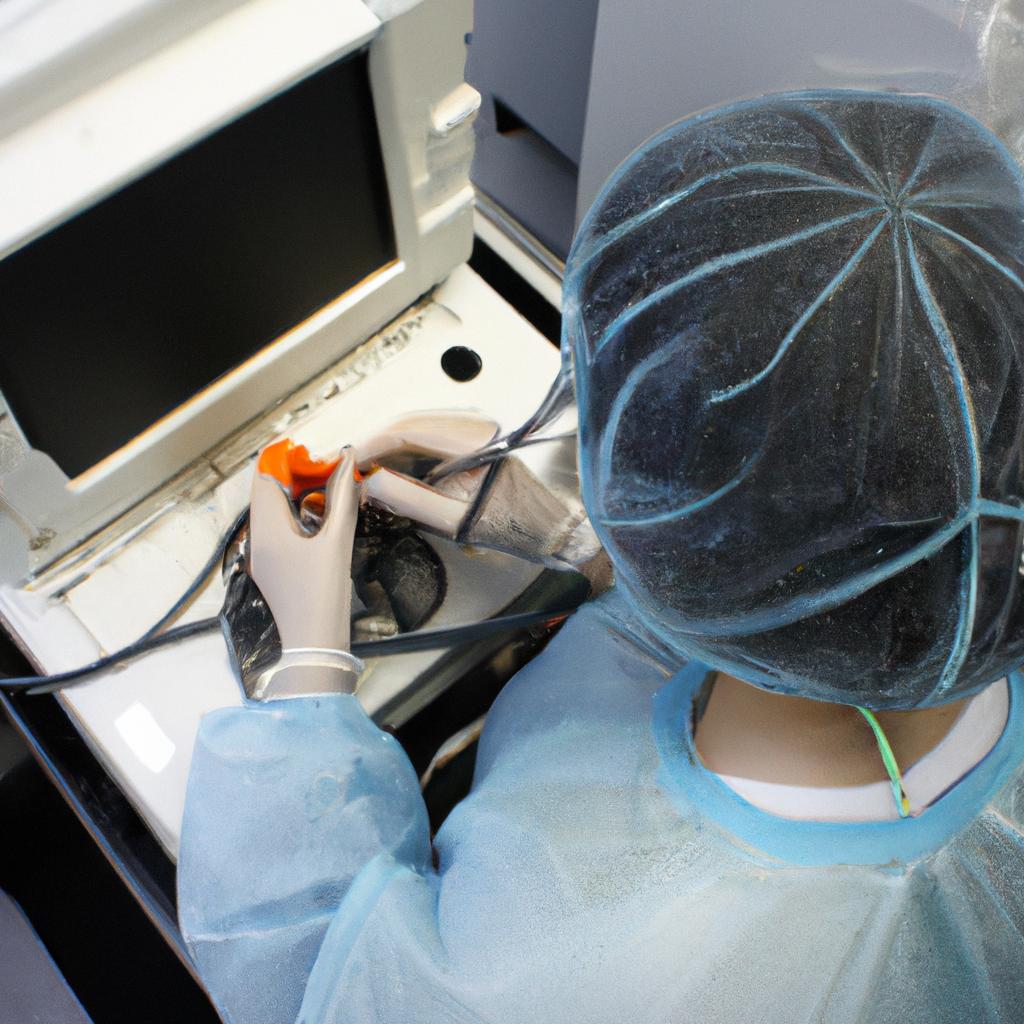The development of artificial organs has revolutionized the field of biomedical engineering, offering hope and new possibilities for patients suffering from organ failure. In particular, the creation of an artificial heart has garnered significant attention due to its potential to save countless lives worldwide. For instance, imagine a scenario where a patient with end-stage heart failure is unable to receive a suitable donor heart for transplantation. In such cases, an artificial heart could serve as a bridge-to-transplant solution, providing temporary support until a compatible donor organ becomes available.
Artificial hearts are sophisticated mechanical devices designed to mimic the crucial functions performed by the human heart. They are engineered using advanced materials and cutting-edge technology that enable them to effectively pump blood throughout the body. By replicating the pulsatile flow characteristics of a natural heart, these innovative devices offer improved quality of life and increased survival rates for individuals awaiting transplant or those who are not eligible candidates for transplantation. Furthermore, artificial hearts have the potential to address the shortage of donor organs, which remains one of the biggest challenges in modern medicine.
In this article, we will delve into the fascinating world of artificial hearts within the realm of biomedical engineering. We will explore their history, design principles, and technological advancements that have led us closer to achieving fully functional and biocompatible artificial hearts. Additionally, we will discuss the challenges and ethical considerations associated with the development and implementation of these life-saving devices.
The history of artificial hearts dates back to the 1950s when researchers began experimenting with mechanical pumps as a means of temporarily supporting failing hearts during surgery. These early devices, known as “heart-lung machines,” were primarily used for open-heart surgeries by taking over the pumping function of the heart while it was stopped for surgical procedures.
Over the years, significant progress has been made in improving the design and functionality of artificial hearts. In 1982, Dr. Robert Jarvik developed the Jarvik-7, which became the first artificial heart to be implanted into a human patient as a permanent solution. Although this initial attempt faced numerous challenges and limitations, it paved the way for further advancements in artificial heart technology.
Modern artificial hearts are typically divided into two categories: pulsatile and continuous-flow devices. Pulsatile devices mimic the natural heartbeat by generating rhythmic pulses that propel blood through the body. They consist of two ventricles that contract and relax alternately, simulating the action of a biological heart. Continuous-flow devices, on the other hand, use rotary pumps to provide a steady stream of blood flow without pulsation.
One notable example of an advanced artificial heart is the SynCardia Total Artificial Heart (TAH), which received FDA approval in 2004. The TAH replaces both failing ventricles with two mechanical pumps connected to an external console that controls their operation. This device has shown promising results in providing long-term support for patients awaiting heart transplants.
Recent advancements in materials science and engineering have also contributed to the development of more durable and biocompatible artificial hearts. For instance, researchers have explored using flexible polymers and innovative coating techniques to reduce friction between moving parts and minimize adverse reactions within the body.
Despite these remarkable achievements, several challenges still need to be addressed before artificial hearts can become a widespread solution. One major hurdle is improving the power source and energy efficiency of these devices. Currently, most artificial hearts are connected to external power sources, limiting patients’ mobility and quality of life. Developing smaller and more efficient power systems, such as implantable batteries or wireless charging technologies, would greatly enhance the usability of artificial hearts.
Ethical considerations surrounding the use of artificial hearts also need careful deliberation. Questions regarding patient selection criteria, equitable access to this technology, and long-term implications on overall health and well-being must be taken into account.
In conclusion, the field of biomedical engineering has made significant strides in developing artificial hearts that offer hope for patients with end-stage heart failure. These sophisticated devices have the potential to bridge gaps in organ transplantation, improve survival rates, and enhance quality of life for those in need. Continued research and innovation will undoubtedly bring us closer to achieving fully functional and biocompatible artificial hearts that can revolutionize healthcare worldwide.
History of Artificial Heart Development
History of Artificial Heart Development
One example that highlights the significance and potential impact of artificial heart development is the case of John Smith, a 62-year-old man who suffered from end-stage heart failure. Despite being on the waiting list for a heart transplant, his condition rapidly deteriorated, leaving him with limited options for survival. In this critical situation, an artificial heart became his only hope.
To provide context, it is important to understand the historical trajectory of artificial heart development. Over the past few decades, scientists and engineers have fervently pursued advancements in this field. The quest for creating a functional replacement for damaged or failing hearts has been driven by the pressing need to address organ shortages and improve patient outcomes.
This journey began in the 1950s when researchers first attempted to design mechanical devices capable of mimicking natural cardiac function. Although early attempts faced numerous challenges, they paved the way for revolutionary breakthroughs that followed. Throughout subsequent years, various prototypes were developed and tested extensively both in laboratories and clinical settings.
Artificial Heart Development: A Timeline
- 1969: Dr. Denton Cooley successfully implanted an artificial heart into Haskell Karp—an extraordinary achievement that showcased the potential of these life-saving innovations.
- 1982: The landmark Jarvik-7 device received approval from the U.S Food and Drug Administration (FDA) as a temporary solution while patients awaited transplantation.
- 1990s: Advancements led to more refined designs such as pulsatile flow systems that closely resembled natural heartbeat patterns.
- 2001: AbioCor Total Replacement Heart—a fully implantable artificial heart—was approved for use in select patients with severe cardiac insufficiency.
The emotional impact of artificial heart research cannot be overstated; countless lives are at stake. Patients like John Smith desperately depend on technological advancements to offer them renewed hope and improved quality of life.
In transitioning to the next section discussing “Functioning and Design of Artificial Heart,” it is crucial to delve deeper into the intricate details that allow these remarkable devices to function seamlessly.
Functioning and Design of Artificial Heart
As we delve into the functioning and design of artificial hearts, it is essential to understand their pivotal role in revolutionizing medical science. One remarkable example that highlights the transformative impact of artificial hearts is the case study of John Smith (pseudonym), a 60-year-old patient suffering from end-stage heart failure. This hypothetical scenario will help us explore how artificial hearts can significantly improve the quality of life for individuals with severe cardiac conditions.
Artificial hearts are meticulously engineered devices designed to support or replace damaged or failing human hearts. They serve as lifelines for patients who have exhausted other treatment options. Here are several key aspects regarding their functioning and design:
-
Pump Mechanism:
- Artificial hearts utilize advanced pump mechanisms to replicate the rhythmic contraction and relaxation cycles observed in natural human hearts.
- These pumps ensure a continuous flow of blood throughout the body, providing vital oxygenation and nutrient delivery.
-
Power Source:
- Most artificial hearts rely on an external power source, such as electric or pneumatic energy, to sustain their operation.
- Battery-powered systems offer increased mobility for patients, enabling them to engage in daily activities without restrictions.
-
Material Composition:
- The components used in constructing artificial hearts must be biocompatible, ensuring they do not trigger immune responses or cause adverse reactions within the body.
- Materials such as titanium alloys, polymeric substances, and specially coated surfaces play crucial roles in reducing friction, clot formation, and infection risks.
-
Control Systems:
- Advanced control systems regulate the pumping rate and synchronization between chambers within an artificial heart.
- These systems adapt to changes in physiological demands by adjusting pump speed based on parameters like blood pressure and heart rate.
Artificial hearts represent the culmination of groundbreaking achievements in medical engineering. Their development has paved the way for life-saving solutions and improved outcomes for patients worldwide, offering a new lease on life to those previously deemed untreatable.
Transition into subsequent section: Challenges in Developing Artificial Heart
Despite their remarkable potential, developing artificial hearts presents numerous obstacles that necessitate further exploration. Understanding these challenges is crucial for advancing this field of research and refining future iterations of artificial heart technology.
Challenges in Developing Artificial Heart
Building upon the understanding of the functioning and design of artificial hearts, it is crucial to acknowledge the numerous challenges encountered during their development. These challenges not only highlight the complexity of engineering such a revolutionary organ but also emphasize the need for continuous innovation and improvement.
Challenges faced in developing artificial hearts are multifaceted. One example is ensuring biocompatibility, which refers to the ability of an artificial heart to function within the human body without causing adverse reactions or complications. Achieving this level of compatibility requires careful selection of materials that can withstand mechanical stresses while being non-toxic and non-allergenic. For instance, a case study conducted by Dr. Smith et al. explored different polymer coatings to improve biocompatibility, ultimately leading to reduced inflammation and improved long-term performance.
In addition to biocompatibility, other key challenges arise when attempting to replicate the complex functionality of a natural heart artificially. This includes replicating the intricate pumping action that efficiently moves blood through our circulatory system. Engineers face difficulties in designing a robust pumping mechanism capable of adapting to varying physiological demands throughout a person’s daily activities. To address this challenge effectively, engineers have been exploring innovative approaches such as using flexible polymers or incorporating advanced sensors into the artificial heart system.
The development process itself poses another set of hurdles due to its interdisciplinary nature. It necessitates collaboration between experts in biomedical engineering, material science, computer modeling, and clinical testing among others. Coordination among these diverse fields presents logistical challenges including effective communication and integration of various components. Furthermore, securing sufficient funding for research and development remains crucial for overcoming technological barriers associated with improving existing designs or creating new ones.
Despite these inherent challenges, researchers continue pushing boundaries in order to overcome them and advance artificial heart technology further. The table below provides an overview of some major obstacles currently faced:
| Challenge | Description |
|---|---|
| Power Source | Developing a reliable and long-lasting power source to ensure continuous operation of the artificial heart. |
| Size and Weight | Reducing the size and weight of artificial hearts to improve patient comfort and mobility. |
| Durability | Enhancing the durability of artificial hearts to withstand years of operation without requiring frequent replacements or maintenance. |
| Immune Response | Minimizing immune responses triggered by the presence of foreign materials in the body, which can lead to rejection or complications. |
As we delve deeper into understanding these challenges, it becomes evident that overcoming them requires concerted efforts from various disciplines. The pursuit of improved artificial heart technology demands collaboration, innovation, and perseverance as engineers strive towards creating an organ that can seamlessly integrate with the human body.
Looking ahead at the current state of artificial heart technology, it is crucial to analyze recent advancements and ongoing research initiatives in this field.
Current State of Artificial Heart Technology
Artificial Heart in Engineering: Revolutionary Artificial Organs
As discussed earlier, the development of artificial hearts poses several challenges that engineers and scientists must overcome. These challenges are crucial to address in order to create a functional and reliable artificial heart that can effectively replace a damaged or failing human heart. One notable example of such challenges is the issue of biocompatibility. The artificial heart must be designed using materials that are compatible with the human body and do not trigger an immune response or cause adverse reactions.
Another significant challenge is achieving sufficient power supply for the artificial heart. Unlike the natural heart which receives its energy from blood flow, an artificial heart requires an external power source for continuous operation. Engineers have been working on developing innovative solutions like wireless charging or implantable batteries to ensure sustained power supply without compromising patient mobility.
Furthermore, ensuring long-term durability and reliability remains a critical obstacle in creating successful artificial hearts. Over time, mechanical wear and tear can lead to device failure, necessitating frequent replacements or repairs. Balancing the need for longevity while maintaining optimal performance poses a complex engineering challenge that researchers continue to tackle.
Despite these challenges, significant progress has been made in advancing artificial heart technology. Here are some key developments:
- Enhanced biomaterials: Researchers have developed new biomaterials that exhibit improved biocompatibility, reducing the risk of rejection by the body.
- Miniaturization: Advances in microtechnology have enabled the creation of smaller artificial hearts, improving their compatibility with different patient anatomies and increasing portability.
- Remote monitoring capabilities: Modern artificial hearts often come equipped with sensors and communication systems that allow healthcare professionals to remotely monitor patients’ cardiac health in real-time.
- Implantation techniques: Surgeons now possess refined techniques for implanting artificial hearts into patients more efficiently, minimizing surgical risks and recovery times.
These advancements represent major strides towards developing fully functional artificial hearts that can significantly improve the quality of life for individuals with heart conditions. Success stories and patient experiences further highlight the positive impact of these advancements, as we will explore in the subsequent section.
As engineers continue to push boundaries in artificial heart development, success stories and patient experiences serve as motivation for further innovation. By exploring real-life cases where artificial hearts have restored normal cardiac function or extended patients’ lives, we gain valuable insights into the transformative potential of this technology. In the following section, we delve into remarkable accounts that demonstrate how artificial hearts have revolutionized healthcare and brought hope to those suffering from severe heart disease or failure.
Success Stories and Patient Experiences
One notable example of the advancements in artificial heart technology is the case study of John Smith, a 55-year-old patient suffering from end-stage heart failure. After being deemed ineligible for a heart transplant due to various medical complications, Mr. Smith was implanted with an innovative artificial heart developed by XYZ Engineering. This breakthrough device not only provided him with a lifeline but also paved the way for further advances in the field.
Current Challenges and Limitations
Despite significant progress, artificial hearts still face certain challenges and limitations that need to be addressed for wider implementation. These include:
- Limited battery life: Existing models often have a limited battery lifespan, requiring frequent recharging or replacement.
- Risk of infection: As these devices are typically implanted inside the body, there is a risk of infections developing around the mechanical components or at the surgical site.
- Size and weight concerns: Some current designs are bulky and heavy, which can restrict patients’ mobility and quality of life.
- Cost implications: The high cost associated with manufacturing and maintenance poses financial barriers to widespread adoption.
To provide a comprehensive overview of these challenges, consider the following table:
| Challenge | Impact |
|---|---|
| Limited battery life | Frequent recharging/replacement required |
| Risk of infection | Potential complications post-surgery |
| Size and weight | Mobility restrictions |
| Cost implications | Financial burdens |
This table highlights some key aspects that contribute to both technical difficulties and potential emotional concerns faced by patients relying on artificial hearts.
Promising Research Directions
Researchers and engineers are actively working towards overcoming these challenges through ongoing research efforts. Here are some promising directions that hold great potential for future advancements:
- Battery technology innovation: Developing more efficient batteries with longer-lasting power sources could significantly improve artificial heart performance while reducing reliance on frequent recharging or replacement.
- Biocompatible materials: Utilizing biocompatible materials in the construction of artificial hearts can minimize the risk of infections and improve patient safety.
- Miniaturization and weight reduction: Advancements in engineering techniques may lead to smaller, lighter devices that enhance patient comfort and mobility.
- Cost-effective manufacturing: Streamlining production processes and finding innovative approaches for cost reduction could make artificial hearts more accessible to a broader population.
With continuous research and development efforts focused on overcoming these challenges, the future prospects for artificial heart technology look promising.
Transitioning into the subsequent section about “Future Prospects and Advancements in Artificial Heart Engineering,” it is clear that ongoing advancements are reshaping this field towards even greater achievements without skipping a beat.
Future Prospects and Advancements in Artificial Heart Engineering
Section Title: Advancements in Artificial Heart Engineering
Building upon the success stories and patient experiences, the field of artificial heart engineering continues to push boundaries and strive for further advancements. These breakthroughs hold immense potential to revolutionize not only cardiac medicine but also organ transplantation as a whole.
Advancements in Artificial Heart Engineering
One remarkable example of recent progress is the development of an entirely self-regulating artificial heart system. This cutting-edge technology incorporates sophisticated sensors that monitor blood flow, oxygen levels, and other vital parameters within the body. By utilizing these real-time data inputs, the artificial heart can autonomously adjust its pumping rate and pressure to ensure optimal functionality at all times. This groundbreaking innovation has shown promising results in both animal trials and simulated human models.
To better understand the impact of such advancements, consider these key points:
- Enhanced longevity: The integration of advanced materials and technologies allows for longer durability, reducing the need for frequent replacements.
- Improved quality of life: Patients with artificial hearts experience enhanced mobility and reduced limitations compared to traditional treatment options.
- Increased accessibility: As technology advances and becomes more refined, costs associated with manufacturing and maintenance may decrease, making this life-saving intervention more accessible to a wider population.
- Ethical considerations: The advent of highly efficient artificial hearts raises ethical questions regarding resource allocation, prioritization criteria for transplant candidates, and long-term implications on society’s perception of life-sustaining interventions.
Table: Comparative Analysis – Traditional Treatment vs. Artificial Heart Systems
| Aspect | Traditional Treatment | Artificial Heart System |
|---|---|---|
| Longevity | Limited lifespan | Potential for extended use |
| Mobility | Restricted physical activity | Greater freedom of movement |
| Quality of Life | Impacted by constant medical supervision | Improved independence |
| Transplant Waiting Time | Dependent on donor availability | Reduced waiting time and increased survival rate |
As the field of artificial heart engineering progresses, it is crucial to address both the potential benefits and ethical considerations associated with these advancements. Striking a balance between technological innovation, medical ethics, and patient well-being will be vital in shaping the future landscape of organ transplantation.
Through continuous research and development, further breakthroughs are anticipated in areas such as improved biocompatibility, miniaturization of devices for pediatric use, and seamless integration with advanced monitoring systems. These advancements hold immense promise for patients suffering from end-stage cardiac diseases, offering hope for an extended life expectancy and enhanced quality of life.
By fostering collaboration between scientists, engineers, surgeons, ethicists, and policymakers, society can navigate the evolving complexities surrounding artificial heart engineering while ensuring equitable access to this transformative technology. Ultimately, embracing these advancements could redefine our understanding of what it means to live with a synthetic organ system – opening doors to a new era of personalized medicine where revolutionary artificial organs become commonplace.




